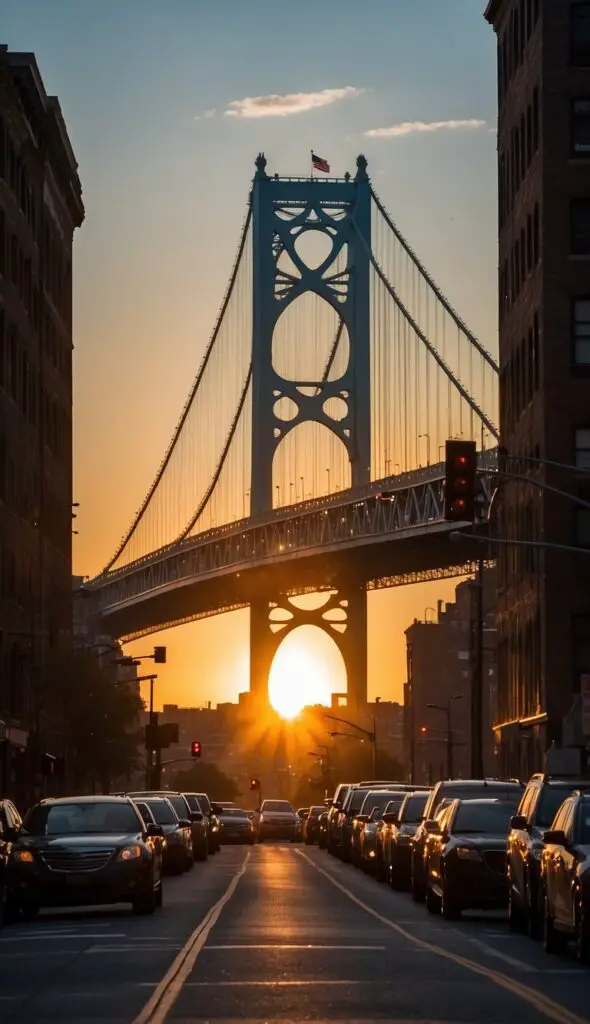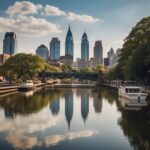Nestled within the heart of Philadelphia’s vibrant skyline, the Benjamin Franklin Bridge stands tall as an iconic symbol of the city’s rich history and architectural grandeur. Spanning the majestic Delaware River, this engineering marvel connects the bustling streets of Philadelphia, Pennsylvania, with the charming neighborhoods of Camden, New Jersey. Named after one of America’s founding fathers, the bridge serves as a tribute to Benjamin Franklin’s legacy, embodying the spirit of innovation and progress that defines both cities.
Surrounding the Benjamin Franklin Bridge, visitors will find themselves immersed in a treasure trove of attractions and green spaces. Just a stone’s throw away lies the historic Old City district, where cobblestone streets lead to renowned landmarks such as Independence Hall and the Liberty Bell. Nearby, the scenic Penn’s Landing offers panoramic views of the waterfront, dotted with charming parks, restaurants, and entertainment venues. For those seeking a cultural escape, the Philadelphia Museum of Art beckons with its world-class collections and iconic “Rocky Steps.”
In addition to its proximity to Philadelphia’s cultural gems, the Benjamin Franklin Bridge also serves as a gateway to the verdant landscapes of Camden’s waterfront. Adventure seekers can explore the sprawling grounds of the Adventure Aquarium, home to a dazzling array of marine life and interactive exhibits. Meanwhile, nature enthusiasts can retreat to the peaceful oasis of Cooper River Park, where scenic trails, boating facilities, and lush greenery await. Whether marveling at architectural splendor, delving into history, or embracing the great outdoors, the Benjamin Franklin Bridge and its surrounding attractions promise an unforgettable urban adventure for visitors of all ages.
Table of Contents
Historical Context
The historical context surrounding the construction of the Benjamin Franklin Bridge is steeped in the dynamic narrative of early 20th-century Philadelphia. As the city burgeoned into a bustling metropolis, the need for a bridge connecting Pennsylvania and New Jersey became increasingly apparent, catalyzed by burgeoning trade and expanding urban populations. This section delves into the socio-economic backdrop and the visionary efforts that propelled the realization of this monumental infrastructure project.
Exploring Philadelphia’s Early 20th Century Landscape
During the early 20th century, Philadelphia pulsated with industrial vigor and urban growth. As one of America’s foremost industrial centers, the city teemed with factories, warehouses, and bustling waterfronts. The Delaware River, a vital artery of commerce, served as a conduit for the transportation of goods and people, linking Philadelphia to neighboring states and regions. However, the absence of a direct bridge connection to New Jersey posed a logistical bottleneck, hindering the seamless flow of trade and commerce. Against this backdrop, the imperative for a bridge spanning the Delaware River crystallized, laying the groundwork for the ambitious endeavor that would culminate in the construction of the Benjamin Franklin Bridge.
Engineering Marvel in the Making
The realization of the Benjamin Franklin Bridge was not merely a feat of engineering prowess but a testament to human ingenuity and perseverance in the face of formidable challenges. Engineers and planners confronted a myriad of obstacles, ranging from technical complexities to financial constraints and logistical hurdles. The task of spanning the wide expanse of the Delaware River, notorious for its strong currents and fluctuating tides, presented a formidable challenge. Moreover, the need to accommodate both vehicular and pedestrian traffic necessitated innovative design solutions and meticulous planning. Despite these daunting challenges, the visionaries behind the project remained undeterred, marshaling their expertise and resources to transform the audacious dream of a trans-Delaware bridge into a tangible reality.
Engineering Marvel
The Benjamin Franklin Bridge stands as a testament to human ingenuity and engineering excellence, a striking emblem of Philadelphia’s skyline and a vital artery of transportation. This section illuminates the bridge’s remarkable construction journey, showcasing the innovative techniques and design ingenuity that culminated in its status as an enduring engineering marvel.
Innovative Engineering Techniques
The construction of the Benjamin Franklin Bridge heralded a new era in bridge engineering, marked by groundbreaking techniques and technological advancements. Engineers employed a bold array of methods to navigate the formidable challenges posed by spanning the wide expanse of the Delaware River. Notably, the use of cantilever construction techniques revolutionized the project, allowing for the simultaneous erection of bridge segments from both sides of the river. This innovative approach expedited the construction process while ensuring structural integrity, showcasing the project’s cutting-edge engineering prowess.
Unique Design Elements
From its soaring towers to its intricate lattice trusses, the Benjamin Franklin Bridge stands as a masterpiece of architectural design, seamlessly marrying form with function. The bridge’s distinctive Gothic-inspired towers, rising majestically above the river’s surface, not only serve as visual beacons but also house intricate machinery and counterweights essential to the bridge’s operation. Meanwhile, its intricate lattice trusses, crafted from steel and wrought iron, imbue the bridge with a sense of timeless elegance while ensuring structural stability and load-bearing capacity. Beyond its utilitarian purpose, the bridge’s design elements contribute to its aesthetic appeal, transforming it into a cherished landmark beloved by residents and visitors alike.
Symbolism and Significance
As more than just a feat of engineering, the Benjamin Franklin Bridge holds profound symbolism and significance for both Philadelphia and the broader region it connects. This section delves into the layers of meaning embedded within its majestic spans, exploring its role as a vital link between states, a cultural icon, and a catalyst for economic growth and regional cohesion.
Linking States, Fostering Connectivity
The Benjamin Franklin Bridge transcends its physical presence, serving as a symbolic bridge between the states of Pennsylvania and New Jersey. Beyond facilitating the movement of vehicles and pedestrians, it embodies the spirit of unity and cooperation between neighboring communities. As a pivotal conduit of regional connectivity, the bridge plays a vital role in facilitating commerce, trade, and cultural exchange, fostering economic growth and collaboration across state lines. Its towering presence serves as a tangible reminder of the ties that bind Philadelphia and Camden, forging a shared destiny rooted in mutual prosperity and interdependence.
Cultural Icon and City Identity: Perched majestically against the backdrop of Philadelphia’s skyline, the Benjamin Franklin Bridge assumes a central role in shaping the city’s cultural identity and sense of place. Its iconic silhouette, punctuated by Gothic-inspired towers and graceful arches, has become synonymous with the city’s ethos of innovation, resilience, and progress. From postcards to paintings, the bridge has been immortalized in countless works of art, capturing the collective imagination of residents and visitors alike. As a beloved landmark, it serves as a gathering point for community celebrations, cultural events, and recreational pursuits, enriching the fabric of Philadelphia’s social and civic life. Indeed, the Benjamin Franklin Bridge stands not only as a marvel of engineering but also as a cherished symbol of Philadelphia’s spirit and heritage.
Evolution and Preservation
The Benjamin Franklin Bridge has stood as a timeless sentinel spanning the Delaware River, witnessing the ebbs and flows of history while remaining a steadfast symbol of Philadelphia’s progress. In this section, we delve into the journey of the bridge’s evolution, tracing its transformation over the decades. Additionally, we explore the meticulous efforts undertaken to preserve its historical legacy while safeguarding its structural integrity for future generations to cherish.
Evolution Through the Decades
Since its inauguration in 1926, the Benjamin Franklin Bridge has undergone a series of transformative changes reflective of the evolving needs and advancements in engineering technology. Over the decades, the bridge has witnessed various renovations and upgrades aimed at enhancing its safety, functionality, and aesthetic appeal. Notable milestones include the introduction of modern traffic management systems, the implementation of seismic retrofitting measures, and the installation of energy-efficient lighting technologies. Each renovation and upgrade has not only extended the bridge’s lifespan but also ensured its continued relevance in a rapidly changing urban landscape.
Preserving Historical Integrity
While embracing progress, preserving the historical integrity of the Benjamin Franklin Bridge remains paramount. Efforts to safeguard its architectural heritage involve a delicate balance between conservation and innovation. Preservation initiatives encompass comprehensive maintenance programs, periodic inspections, and meticulous restoration projects aimed at retaining the bridge’s original character and charm. Additionally, community engagement plays a vital role in advocating for the preservation of the bridge’s historical significance, fostering a sense of stewardship among residents and stakeholders. By marrying preservation with modernization, the Benjamin Franklin Bridge continues to stand as a timeless testament to Philadelphia’s past, present, and future.
Community Impact
Beyond its role as a mere conduit for transportation, the Benjamin Franklin Bridge serves as a vital artery pulsating with the lifeblood of Philadelphia and Camden, New Jersey. This section delves into the multifaceted impact of the bridge on the surrounding communities, exploring its transformative influence on urban development, transportation patterns, and cultural traditions cherished by local residents.
Shaping Communities and Urban Development
he Benjamin Franklin Bridge exerts a profound influence on the fabric of Philadelphia and Camden, shaping the contours of urban development and transportation infrastructure. Its strategic location serves as a catalyst for economic growth, attracting businesses, residents, and visitors to the vibrant neighborhoods nestled along its span. The bridge’s accessibility facilitates the seamless movement of goods and people between the two cities, fostering regional connectivity and collaboration. Moreover, its presence has spurred the revitalization of waterfront districts, transforming once-neglected areas into vibrant hubs of activity teeming with shops, restaurants, and cultural amenities. As a linchpin of urban development, the Benjamin Franklin Bridge continues to play a pivotal role in shaping the dynamic landscapes of Philadelphia and Camden.
Cultural Events and Traditions
The Benjamin Franklin Bridge transcends its utilitarian function, assuming a cherished place in the hearts and minds of local residents. Throughout the year, the bridge serves as a backdrop for an array of cultural events and traditions that celebrate its rich heritage and significance. From annual festivals and parades to community gatherings and artistic performances, the bridge becomes a focal point for collective celebration and camaraderie. Notably, events such as the Philadelphia Marathon, which features a scenic route across the bridge, showcase the bridge’s role in fostering a sense of unity and pride among participants and spectators alike. As a cherished symbol of civic identity, the Benjamin Franklin Bridge continues to inspire a myriad of cultural expressions that resonate deeply with the diverse communities it serves.
Conclusion
In conclusion, the Benjamin Franklin Bridge stands as more than just a monumental structure of steel and concrete; it embodies the spirit of innovation, resilience, and community that defines the cities of Philadelphia and Camden. Over its storied history, this architectural marvel has served as a vital lifeline, connecting diverse communities, fostering economic growth, and enriching the cultural tapestry of the region. From its inception as a visionary dream to its enduring legacy as a beloved landmark, the bridge stands as a testament to the ingenuity and determination of those who conceived and constructed it.
As we reflect on the journey of the Benjamin Franklin Bridge, we are reminded of its enduring significance as a symbol of unity and progress. Through decades of evolution and preservation, the bridge has remained a beacon of hope and inspiration, bridging not only the physical divide between states but also the barriers of time and space that separate communities. Moving forward, it is imperative that we continue to honor and preserve the legacy of the Benjamin Franklin Bridge, ensuring that future generations may continue to marvel at its beauty and appreciate its profound impact on the cities and people it serves. In doing so, we uphold the values of innovation, collaboration, and civic pride that lie at the heart of this iconic structure, ensuring that its legacy endures for generations to come.






